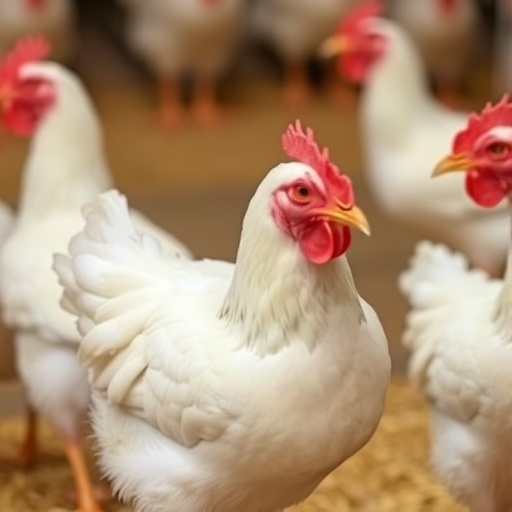
In the intricate world of poultry nutrition, precise optimization of feed components can yield transformative economic and sustainability impacts. Recent research conducted by Ben Parsons and colleagues at the University of Arkansas’ Arkansas Agricultural Experiment Station delves deeply into a complex but critically important nutrient: calcium. Their study meticulously compares two methodologies designed to measure calcium bioavailability in broiler chickens, revealing new avenues to enhance feed efficiency and poultry production outcomes on a grand scale.
Calcium is conventionally recognized for its role in strengthening skeletal structure and facilitating muscle contractions in poultry. However, beyond these physiological necessities, calcium’s influence extends into the realm of feed conversion efficiency — a paramount factor dictating the profitability and environmental footprint of broiler production. The quintessential challenge lies not merely in quantifying total calcium intake but discerning how much of that calcium is actually bioavailable, i.e., absorbed and metabolically utilized by the bird.
The research highlights that traditional methods of analyzing calcium content in feed samples are fraught with variability. Calcium sources commonly used, such as dicalcium phosphate and limestone, are mineral-based and inherently heterogeneous. Variations in particle size and composition generate inconsistencies in laboratory measurements, complicating the quest for precise nutritional formulations. This opens the door for innovative approaches to reliably assess calcium bioavailability.
.adsslot_kLA5760dFv{width:728px !important;height:90px !important;}
@media(max-width:1199px){ .adsslot_kLA5760dFv{width:468px !important;height:60px !important;}
}
@media(max-width:767px){ .adsslot_kLA5760dFv{width:320px !important;height:50px !important;}
}
ADVERTISEMENT
To address these technical obstacles, Parsons and his team investigated two distinct techniques: the established bone ash method and a newer, expedited apparent ileal digestibility test. The bone ash technique, rooted in decades of mineral nutrition research, estimates calcium bioavailability by measuring calcium accumulation in bone tissue, specifically through ash content analysis post-incineration of leg bones. While highly informative about systemic calcium utilization, this method demands extended experimental durations—often spanning two weeks—and requires multiple diet variations to generate robust data.
Contrastingly, the apparent ileal digestibility test offers a swift alternative. It quantifies calcium absorption by collecting digesta from the ileum—the terminal portion of the small intestine—after feeding trials. The differential between calcium content in the feed and residual calcium in the digesta reflects the portion absorbed by the bird. This technique not only reduces testing time remarkably, often achievable within 24 to 72 hours, but also limits dietary complexity, enabling broader screening of calcium sources.
Parsons’ findings illustrate a compelling concordance between the two methods, validating the newer digestibility test as a reliable proxy for calcium bioavailability. This breakthrough empowers feed formulators with rapid, reproducible data, facilitating nuanced adjustments to calcium inclusion rates and source selections that align closely with physiological demands.
The economic significance of optimizing calcium digestibility cannot be overstated. Arkansas itself ranks as the nation’s third-largest broiler producer, with output exceeding 7.4 billion pounds annually. Even marginal disparities in feed conversion ratios hold profound financial ramifications, potentially translating into multi-million-dollar losses when scaled across industrial operations. Excessive or insufficient calcium impairs nutrient balance, reduces phosphorus availability, and exacerbates health challenges such as disease susceptibility, underscoring the imperative for precision feeding strategies.
Moreover, this research reveals that limestone, the most prevalent calcium source in poultry diets, exhibits wide-ranging digestibility profiles, from as low as 20 percent to nearly 80 percent. Utilizing limestone with inappropriate solubility characteristics can hinder nutrient absorption and diminish overall bird performance. The identification of a “sweet spot” in solubility—where calcium is neither too rapidly dissolved to interfere with other minerals nor too slowly released to limit availability—is a crucial step forward.
The implications extend beyond calcium alone. Fine-tuning mineral nutrition through reliable, rapid bioavailability assessments can reduce feed redundancy and environmental waste, curtail disease risks, and improve growth efficiency. By embracing digestible calcium requirements rather than total calcium metrics, poultry nutritionists herald a paradigm shift rooted in data-driven precision agriculture.
Supporting this transition, doctoral candidate Rebekah Drysdale’s master’s thesis refined the bone ash method through innovative regression models tailored to calcium, enhancing the specificity and applicability of this traditional assay. Collaborative efforts within the Center of Excellence for Poultry Science, including contributions from program technician Seth Hufford, further solidify the methodological rigor of these advancements.
Parsons envisions the next frontier in calcium nutrition as the development of comprehensive databases cataloguing the bioavailability of diverse calcium sources. Equipped with such datasets, feed manufacturers can rapidly identify suboptimal sources, mitigate nutritional inconsistencies, and strategically source feed ingredients. This knowledge will underpin more sustainable and profitable poultry production systems.
The timing of this research is particularly pertinent given evolving industry pressures toward sustainable intensification and reducing environmental footprints. Enhanced feed conversion efficiency reduces resource inputs and waste outputs, aligning poultry production with global sustainability targets.
In sum, the synergy between classic and contemporary analytical methods for calcium bioavailability exemplifies the innovation necessary to refine poultry nutrition at both micro and macro scales. Parsons and his colleagues’ work lays a critical foundation for precision mineral nutrition, offering tangible benefits from economic savings to animal health improvements, ultimately reimagining how a fundamental nutrient shapes the future of poultry science.
Subject of Research: Animals
Article Title: Comparison of relative calcium bioavailability based on bone ash and apparent ileal Ca digestibility in broiler chickens
News Publication Date: 12-Aug-2025
Web References:
Arkansas Agricultural Profile
Poultry Science Journal Article DOI
Arkansas Agricultural Experiment Station website
References:
Drysdale, R., Parsons, B. et al. “Comparison of relative calcium bioavailability based on bone ash and apparent ileal Ca digestibility in broiler chickens.” Poultry Science, 2025.
Image Credits:
Credit: U of A System Division of Agriculture photo
Keywords:
Livestock, Chemical elements, Vitamins, Nutrition, Biochemistry, Food science, Agricultural chemistry, Chemical biology
Tags: advancements in poultry feed formulationCalcium bioavailability in poultrycalcium sources for poultrycalcium testing methodologieschallenges in calcium measurement in poultry.economic impacts of poultry feedenhancing broiler production outcomesfeed efficiency in broiler chickensmeasuring calcium in feed samplespoultry nutrition optimizationresearch on poultry nutritionsustainability in poultry production





